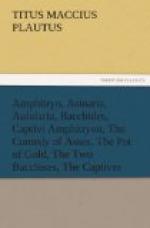Very few of his extant comedies can be dated, so far as the year of their production in Rome is concerned, with any great degree of certainty. The Miles Gloriosus appeared about 206, the Cistellaria about 202, Stichus in 200, Pseudolus in 191 B.C.; the Truculentus, like Pseudolus, was composed when Plautus was an old man, not many years before his death in 184 B.C.
Welcome as a full autobiography of Plautus would be, in place of such scant and tasteless biographical morsels as we do have, only less welcome, perhaps, would be his own stage directions for his plays, supposing him to have written stage directions and to have written them with something more than even modern fullness. We should learn how he met the stage conventions and limitations of his day; how successfully he could, by make-up and mannerism, bring on the boards palpably different persons in the Scapins and Bobadils and Doll Tear-sheets that on the printed page often seem so confusingly similar, and most important, we should learn precisely what sort of dramatist he was and wished to be.
If Plautus himself greatly cared or expected his restless, uncultivated, fun-seeking audience to care, about the construction of his plays, one must criticize him and rank him on a very different basis than if his main, and often his sole, object was to amuse the groundlings. If he often took himself and his art with hardly more seriousness than does the writer of the vaudeville skit or musical comedy of to-day, if he often wished primarily to gain the immediate laugh, then much of Langen’s long list of the playwright’s dramatic delinquencies is somewhat beside its intended point.
And in large measure this—to hold his audience by any means—does seem to have been his ambition: if the joke mars the part, down with the part; if the ludicrous scene interrupts the development of the plot, down with the plot. We have plenty of verbal evidence that the dramatist frequently chose to let his characters become caricatures; we have some verbal evidence that their “stage business” was sometimes made laughably extravagant; in many cases it is sufficiently obvious that he expected his actors to indulge in grotesqueries, well or ill timed, no matter, provided they brought guffaws. It is probable, therefore, that in many other cases, where the tone and “stage business” are not as obvious, where an actor’s high seriousness might elicit catcalls, and burlesque certainly would elicit chuckles, Plautus wished his players to avoid the catcalls.
This is by no means the universal rule. In the writer of the Captivi, for instance, we are dealing with a dramatist whose aims are different and higher. Though Lessing’s encomium of the play is one to which not all of us can assent, and though even the Captivi shows some technical flaws, it is a work which must be rated according to the standards we apply to a Minna von Barnhelm rather than according to those applied to a Pinafore: here, certainly, we have comedy, not farce.




